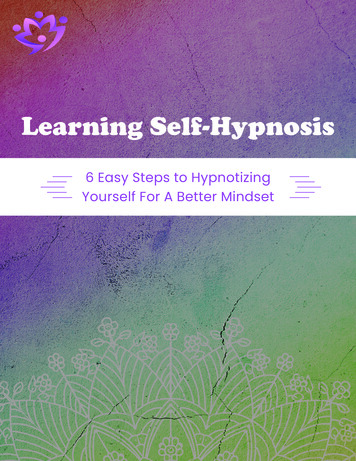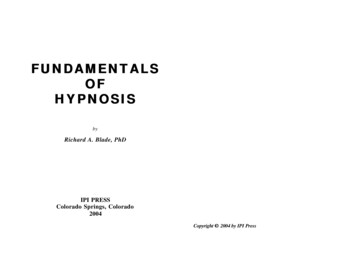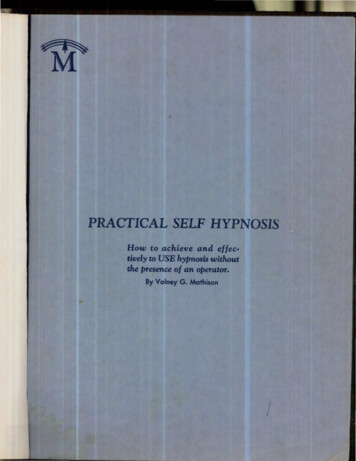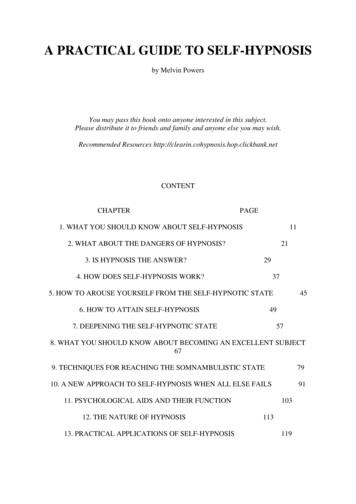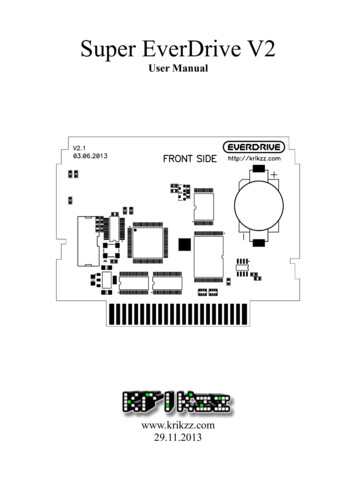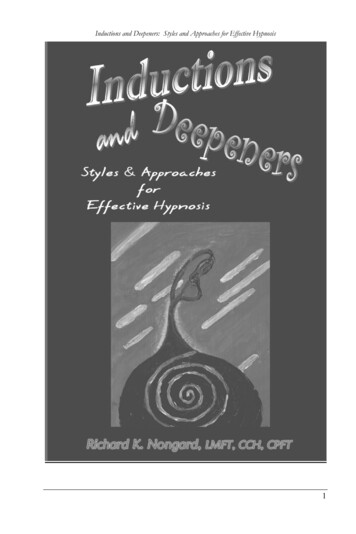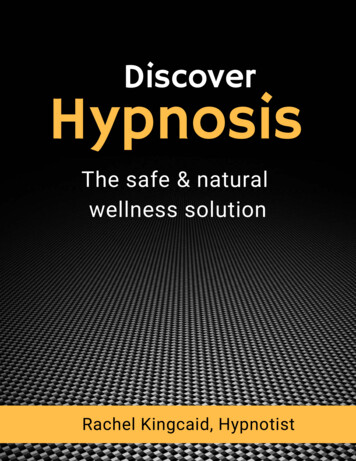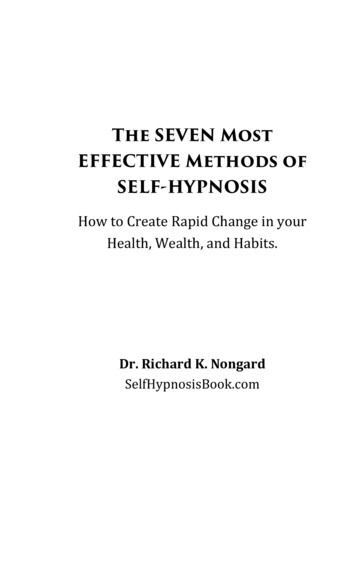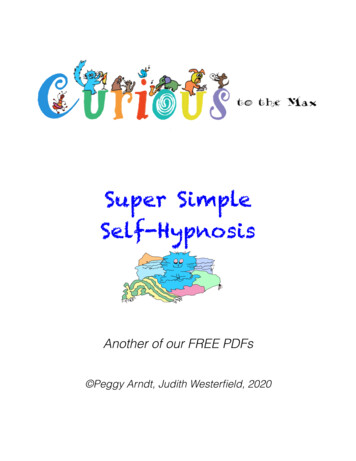
Transcription
Super SimpleSelf-HypnosisAnother of our FREE PDFsfi Peggy Arndt, Judith Wester eld, 2020
Super Simple Self-HypnosisI promise! You won’t squawk like a chicken, forgetyour name or act like you’ve been on a drunken binge.I promise!The worst that happens is you will feel wonderfully relaxed.Let’s remove two of the most common misconceptions first.1. Will I lose Control? You are fully in control and cannot, willnot, do anything that you don’t choose to do. As a matter offact, the aim is to give you more control over your physicalbeing, more control with stress levels, even more control withpain levels.2. Can I be hypnotized? No secrets here. You already know allabout being hypnotized. When’s the last time you “spaced” outwatching TV, reading a book, listening to your partner, friend,child (heaven’s never!) or driving (yikes)? Your brain constantlytunes into the natural state of hypnosis. Some people are moreeasily hypnotized while others have what is called “lowhypnotizability” (that’s a mouthful). But with increased practiceeveryone is capable of entering some level of “trance”.How does hypnosis work?If I knew how hypnosis worked I’d be a very rich woman. No onereally knows exactly how the brain works consciously orunconsciously. Research using SPECT, PET scans and fMRIindicate that hypnosis involves different brain wave patterns anddifferent parts of the brain than during normal conscious awareness.But so far, no one has been able to definitively identify what happens.What we do know is hypnosis is not sleep. During hypnosis theunconscious is more receptive to positive suggestion andaffirmation. The thinking part of the mind “relaxes” letting insuggestions and creates new ways of reacting and relating to yourlife.
The unconscious mind can let go of old unwanted feelings, patterns.Hypnosis can lower blood pressure, decrease stress, strengthenyour immune system and ease pain. People have used it to eraseheadaches, remove traumatic memory, improve self-confidence &self-esteem and forgo anesthesia during surgery or childbirth.Self-hypnosis vs. Seeing a Hypnotherapist.Essentially hypnosis is a concentrated state of focusedawareness. And all hypnosis is really self-hypnosis. When youpractice self-hypnosis your conscious, cognitive mind is still engagedas you tell yourself the positive suggestions. When you see ahypnotherapist you can disengage from your cognitive, consciousmind and let the hypnotherapist talk to your unconscious. Generallyspeaking you can achieve a deeper state of trance with ahypnotherapist. But unless you have your own private live-inhypnotherapist self-hypnosis is always available - you can do selfhypnosis almost anytime, anyplace . . . and once you learn it it’s free!Self-Talk and the UnconsciousHow many times do we say to ourselves: “I’m so tired.” I’m scared”,I’ll never figure this out”, “I can’t take this anymore”? “It will never getany better.” Your unconscious is listening. It’s always listening.As a matter of fact, it is speculated that 95% of our actions areguided, if not dictated, by unconscious processes. We unknowinglyreinforce negative behaviors, expectations and feelings by what wetell ourselves. It’s a well established that negative self-talk underliesdepression and reinforces anxiety and trauma.You can stop negative, unconscious driven self-talk by consciouslybreaking into your thought pattern. Self-hypnosis helps youpurposely, instead of accidentally, give positive suggestion andimages to your unconscious to guide yourself into healthy, productivebehaviors.
First, let’s take a look at what I’m NOT going to teach you:I’m not going to teach you to do a long progressive relaxation – youknow the part where the hypnotherapist tells you to relax every bone,muscle, tendon, and organ and body part in descending order. Thatdrrrrrrrives me crazy. By the time my toes are relaxed all the rest ofmy body parts are progressively tense again. If you already know that“progressive” relaxation works for you then ignore me and do it.I’m NOT going to tell you to light candles, inhale incense or sit by arunning brook. You can do those things if you choose. You canhypnotize yourself sitting on the john or standing in line if you choose.Remember hypnosis is a natural state you already do.I’m NOT going to give you a script that is so long the only way youcould follow it is to have someone else read it to you.Second, here’s what NOT to expect from your power ofconcentration:Your mind is NOT going to stay focused. Whether you are doing selfhypnosis or being guided by a hypnotherapist your mind is going towander. Some refer to it as our “monkey mind” – swinging from treeto tree and avoiding “landing”. It’s not a question of IF your mind willswing and wander it’s a matter of WHEN. Know it’s normal andsimply bring your mind back to your focusThird, there are lots and lots of ways to hypnotize yourself,ON PURPOSE.I’m going to give you one of the very easiest. So easy you can do itmost anytime, most anyplace (NEVER, NO, NOT driving, asking for araise, bar-b-queuing, hang gliding, preparing your income tax or anyother activity where being alert is helpful)
We’ll concentrate on these 7 steps:1.2.3.4.5.6.7.Choose your issueIdentify negative thoughts or beliefsCreate a Positive Statement or AffirmationFind a quiet placeChoose an InductionUse ImageryPractice the Corresponding Behavior1. Choose your issue/concern/problemPick something you’d like to work on– an issue, situation or concern youwant to be different, or better.Don’t pick something that involves someoneelse. I can hypnotize myself forever trying toget my goldfish to be happier.After the self-hypnosis I will feel morerelaxed but my fish ain’t gonna swimmore joyfully. If your issue is for YOU to havea different attitude or better thinking process at leastYOU will have more fun watching the fish swim.To begin, pick a small appetizer, not the whole meal. You want tobuild success. Don’t tackle losing 100 pounds in 2 months or alwaysbeing happy. Focus on one quality or attribute you need to take smallsteps to your goal. Choose something your would like to focus on during yourself-hypnosis. It can be as simple as feeling relaxed or ascomplicated as having less pain.Examples: I will eat more vegetables & less sweets; I willgo to bed earlier; I will think before I speakYou get the picture. Focus on something about you – somethingunder your control, something concrete.
Write your focus downMy issue or concern I want to be different, better:Examples: overweight; no energy; get angry too quickly; trouble falling asleep.2. Identify Negative thoughts or beliefsThis could be an entire book itself. Before you can identify a positivethought to teach your unconscious mind it is important to identify thenegative things you consciously or unconsciously tell yourself aboutyour issue or concern. Sometimes these are things you’ve heardothers say to you or about you. Sometimes you are creative enoughon your own to make them up.It will make your self-hypnosis more affective when you first identifyunconscious negativity so that negativity doesn’t unconsciouslycompete with your positive hypnotic suggestion.Focus on the issue or concern you chose in #1. Take a few momentsto brainstorm with yourself all the negative messages, all the negativenames and labels you’ve heard or said to yourself. (Examples: I amfat, I am a sugar junkie, I will never feel better, I am afraid of publicspeaking, I am stressed-out, I’m never going to get to sleep, I’m lazy& unmotivated, this will never end . . .)Now identify the negative thoughts you’ve been telling yourself orhearing from others that are getting in the way of your goal
Focus on the issue or concern you chose in #1. Take a few momentsto brainstorm with yourself all the negative messages, all the negativenames and labels you’ve heard or said to yourself.Write down your Negative MessagesExamples: I’m fat, I am a sugar junkie, I will never feel better, I am afraid of publicspeaking, I am stressed-out, I’m never going to get to sleep, I’m lazy &unmotivated, I’m a loser (not to be confused with losing weight!), I feel bad, I’mtired, It won’t work, It never works, I’m a ditz! This will never end . . .Notice how much more room in this step I gave you to write! Weall tell ourselves negative messages or give ourselves negativelabels. Remember your unconscious mind is always listening,believes what it hears and helps you remember.
What I want to happenBased on #1 Choose your issue/concern/problem define veryspecifically and concretely what you want, how you want it.Here’s where you narrow what you want to happen even more. Yourunconscious mind can be very concrete so we want to make it aseasy as possible for your unconscious to learn a better way. Definewhat will help you achieve your goal.What I need to do, feel, practice, accomplish etc:Examples: I should eat more vegetables & less sweets, I need to go to bedearlier, I need to think before I speak, I need to concentrate,I want to loose 10 pounds, I want to feel good;, I want to be calmer, I want toquickly fall asleep, I want to pass my exam, I need to relax etc.
3. Create a Positive Statement or AffirmationIt’s easy: Affirmation is statement that’s simple, positive andmemorable. Research actually shows that “talking to yourself” usingpositive statements can impact the brain and therefore the body inpositive ways and enhance your state of both mental and physicalwell-being.Write down what you want your unconscious to hear. Keep it simple – The fewer words the better. Keep it sweet – Make a positive statement. Keep it personal – Begin with “I”.Examples:Lose weight: I am confident, I make the right choices.Have energy: I feel energetic or I have enough energy to do whatI need to do.Stop smoking: I control my choicesBe Happier: I am happy (sometimes simple is all you need!)Less Stress: I am relaxed and comfortable, I feel goodLess Pain: I feel good or “Everyday in every way I feel better andbetter” (Coue)My Affirmation:
Now you’ve set the groundwork, narrowed your focus and chosean affirmation all of which optimizes positive results4. Find a quiet placeFind a quiet place where you will be free from distractions, like food inthe refrigerator, TV, pets and people. Find a comfortable place tosit rather than lie down since the objective is self-hypnosis not sleep.You can use hypnosis to relax into sleep but practice sitting up so youcan use it for things besides snoozing.It is helpful to set a timer for 10-15 minutes. That way you won’t bedistracted by wondering how long it’s been or peeking at a clock.Loosen any tight clothing, kick off your shoes and get comfortable.In other words, minimize any possible distractions.Consumer alert!Do NOT do self-hypnosis while driving any vehicle, climbing ladders,preparing your income tax, mowing the lawn or doing anything whereyou need your full conscious attention to be safe. Self-hypnotize onlywhen you do not have to be fully aware and conscious!5. Choose the InductionAn induction is a way of helping you change your focus from your“outside” world to your inner world. It’s a way of telling your brain “It’stime!” The nice thing about an induction is that if you do it oftenenough it becomes a conditioned response (Lingo for it becoming afamiliar and automatic signal to your brain to go inward).
Here are two inductions that are quick, easy to do and remember.You can choose one or combine them both. The order doesn’tmatter. You’ll know what you preferSignal Breath:Here’s my favorite induction. It’s easy, (you already know how tobreath) it’s fast and it works. You can close your eyes or keep them open. If you chooseto keep your eyes open focus on an object directly in frontof you a few feet away. Take a long deep breath through your nose, expandingyour abdomen. Hold the breath for just a few seconds. Release it through your nose very slowly, very gently,contracting (deflating) your abdomen. As you exhale deepen your sense of relaxation in the waythat’s right for you. Do this two more times, each time relaxing into the breath.Count-DOWN In your mind’s eye, picture yourself going down a stairway,elevator, escalator, path, spiral – whatever feelscomfortable for you. As you picture yourself “going down” count backwardsfrom 10 to 1. Take a breath between, or on, each count, letting yourselfrelax more and more with each count.
See, YOU are in control!The more often you practice the faster the induction becomes imbedded inmemory and the quicker and easier it works.6. Use ImageryWhen you are doing self-hypnosis and have no one to guide you to help describea scene the easiest way is to create your own is through your imagination.There is no right or wrong way to imagine. There are no right or wrong personalimages.IMPORTANT NOTE! You might “see” images like a vivid picture or you might justhave a sense, an intuitive “knowing”. You are in control so you can change the images, rearrangethem, let them go and create what is right for you. Each time you practice self-hypnosis your images mayalways be the same or change. Trust your intuitive sense.1. In your mind’s eye imagine an image of a “safe” orcomfortable place. a serene, or beautiful location. It can beindoors or outside, real or imaginary.2. Notice what creates the sense of serenity, beauty or safety:colors, sounds, time of day or evening, the temperature?3. Stay with your special place for as long as you want.4. Take it all in and let yourself relax even more.5. Imagine all your negative thoughts or beliefs vanishing.Examples: Imagine the negativity evaporating, or going up in a puff of smoke,burying it deep in the ground or throwing it into the sea etc.
7. Practice the corresponding behaviorCreate a Positive Image of YourselfRepeat your affirmation silently, over and over, whileimagining how you would look, act, what you would wear,how you would feel etc. all the qualities & attributes’, whichmatch the affirmation, you’ve picked.Couple your positive self image with your desired outcome orgoal1. Imagine specific situations that are likely to happen inthe coming week when you want to use your affirmation.Imagine how those situations would occur when you arelooking acting, and feeling just like your affirmation. Inother words, bring your positive affirmation qualities &attributes to the situation(s). Do this for as manysituations as you’d like, imagining how you will act toachieve your goals.2. Practice matching image and your affirmation until yourtime is up. Then simply open your eyes and take a fewminutes to complete your worksheet.3. Visualize the situation and feelings you WANT. Start atthe beginning and slowly review it in as much detail aspossibleLinger LongerStay in your relaxed hypnotic state as long as you choose. You canchange the order of the steps, repeat steps or create your own steps . . make it right for you,Open your eyes when your timer rings or you decide to stop.No fancy tricks. You’re always in control.
Repetition helps solidify what you want your unconscious mindto learn.Practicing for only 10 - 15 minutes a day is all you need to do. Youmight even be surprised at how quickly you can relax and go inward.Pick a time where you will practice your self-hypnosis during theweek:Do NOT practice while driving any vehicle, eating, cooking, or, doingyour taxes!Practice only when you do not have to be fully aware and conscious!IMPORTANT NOTE!Your mind will wander. This is normal and natural. When you areaware of your mind wandering simply bring it back to your affirmationand the matching image.Remember, you are in control. You can change the image in any wayyou choose, create a fantasy image etc. If you have troubleimagining yourself imagine what other people (real, imaginary,famous) might look and act like when they match your affirmation andsituations.
Self Hypnosis Reminder WorksheetDon’t skip this step. Make notes after your session to remember what happenedand what changes you might want to try. After a few times you will rememberexactly what steps are best for you.My issue/problem/concernNegative thoughts or beliefs I let goMy Positive Statement or AffirmationVisualizing - Imagery Rehearsal ImagesHow I will use my affirmation(s) in the coming weeks toreinforce my hypnotic cues.I willI willI will
Practice makes PerfectIn the end, it matters less what we think or feel, consciously or unconsciously andmatters more how we behave. So not only do you have to practice self-hypnosisto become good at it, you have to practice doing behaviors that support whatyou want to happen in your life.Hypnosis is not magic but when you back it up with behavior your unconsciousand conscious minds work in unison. Research shows that thinking positivelyhelps your mental, emotional and physical well being. Doing good deeds(for yourself and others) creates a sense of accomplishment, purpose and thesatisfaction of living a good life.Bonus!Self Hypnosis on the RunDon’t wait to do a full self-hypnosis session. Every time you areaware of a negative thought do this:1. Take a deep breath2. Relax into it3. Replace the negative thought with your affirmation.The more you program your mind with positive thoughts the easier, quicker
Let us know how self-hypnosis works for you!Email us at peggyjudytime@gmail.comPeggy & JudyAll the material in this e-booklet is from a 6-hour workshop Ipresented many times over the 30 years I was in practice as alicensed Marriage, Family Therapist (LMFT RET), certifiedhypnotherapist and Interactive Guided Imagery instructor.Now retired, Peggy Arndt, LMFT, RET and I have partnered tocontinue teaching others how to use the tools and techniques weknow work. Our goal is to continue helping people live their best lives.When we started practicing the Internet was non-existent. Yes,we are THAT old. But we are proof “you can teach an old dog newtricks” and have become bloggers, authors and illustrators to share allthings for mental, physical and emotional wellness.DisclaimerThe information herein, including text, graphics and references, is for educationalpurposes only and not medical advice. The content is not intended to be asubstitute for professional medical advice, diagnosis or treatment. Always seekthe advice of your physician or other qualified health provider with any questionsyou have regarding a medical or emotional condition. Never disregardprofessional medical advice and treatment or delay in seeking them because ofsomething you have read here. Neither the authors nor the publisher can be heldresponsible for any loss or claim arising out of the use, or misuse of thesuggestions made herein
Subscribe to our KNEWS letter to be noti ed of new FreePDF's by sending your name and email to:peggyjudytime@gmail.com.Don’t stop there, take a look at our blogsCurious to the Max is a blog about stuff that makes us love, learnand laugh. Art, prose, poetry, personal re ection, inspiration, animalsand FREEBIEShttps://judithwesterfield.comMax Your Mind is a blog about self-care tips, tools, techniques &neuroscience research for MIND, BODY & SOUL – shared with awink and a smile.https://peggyarndt.comCheck out the picture books we have written, on Amazon!fifl"The Pulling, Climbing, Falling Down Tale of Maui and His Back Legs",Peggy Arndt"The Real Tale of Little Red Riding Hood & the Wolf", Judith Westerfield
Hypnosis can lower blood pressure, decrease stress, strengthen your immune system and ease pain. People have used it to erase headaches, remove traumatic memory, improve self-confidence & self-esteem and forgo anesthesia during surgery or childbirth. Self-hypnosis vs. Seeing a Hypnotherapist. Essentially
